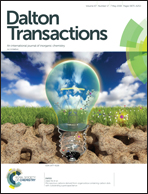High-temperature reversible phase transitions and exceptional dielectric anomalies in cobalt(ii) based ionic crystals: [Me3NCH2X]2[CoX4] (X = Cl and Br)†
Abstract
Two isostructural ionic cobalt(II) halides, trimethylchloromethyl ammonium tetrachlorocobalt(II) (1, [Me3NCH2Cl]2[CoCl4]) and trimethylbromomethyl ammonium tetrabromocobalt(II) (2, [Me3NCH2Br]2[CoBr4]), have been discovered as new high-temperature phase transition materials. 1 exhibits two successive structural phase transitions from P212121 to P21/c at 252 K and then to Pnma at 335 K, accompanied by step-like dielectric anomalies. The two-step sequential reversible phase transitions of 1 derive from the order–disorder transformation of CoCl4 anions and organic Me3NCH2Cl cations, respectively. Its analogue 2 also crystallizes in P21/c at 293 K by changing the halogen atoms of both cations and anions of 1. Unlike 1, 2 displays only one structural phase transition with a much higher transition temperature at 387 K, which is mainly influenced by intermolecular interactions and more energy is required to provide the freedom of the motion. All the findings in the present work indicate that the phase transition temperature and properties of materials can be tuned by using halogens in this series of compounds, which could open a new way to design and assemble novel high-temperature phase transition materials.
![Graphical abstract: High-temperature reversible phase transitions and exceptional dielectric anomalies in cobalt(ii) based ionic crystals: [Me3NCH2X]2[CoX4] (X = Cl and Br)](/en/Image/Get?imageInfo.ImageType=GA&imageInfo.ImageIdentifier.ManuscriptID=C8DT00786A&imageInfo.ImageIdentifier.Year=2018)


 Please wait while we load your content...
Please wait while we load your content...